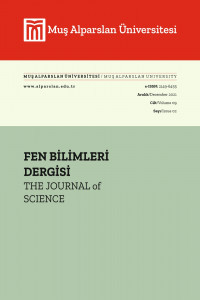Jeomanyetik fırtına süresince NeQuick2 Modelinin Performansı
Bu çalışmanın amacı, NeQuick 2 modelinin jeomanyetik fırtına sürecinde performansını değerlendirmektir. Bu amaçla, NeQuick 2 modelinden ve GPS alıcısından elde edilen dikey toplam elektron içeriği (VTEC) değerleri 05-09 Eylül 2017 tarihleri arasında 5 farklı enlem bölgesinden seçilen beş istasyon için karşılaştırıldı. Karşılaştırma korelasyon, kök ortalama kare hatası (RMSE) ve fark alma yöntemleri ile yapıldı. NeQuick 2 ve GPS tarafından elde edilen TEC değerlerinin değişimi, faz kaymaları ve genlik farkları olmasına rağmen, genellikle benzerdir. Maksimum korelasyon fırtına öncesi sakin günlerde ekvator bölgesinde gözlenirken (5-6 Eylül) ekvatordan uzaklaştıkça korelasyon katsayısı azalmıştır. Maksimum korelasyon katsayısı fırtınanın başlangıç, ana ve dönüş evrelerinde güney yarımkürenin orta enleminde hesaplanmıştır. Ek olarak, en düşük korelasyon kuzey yarımkürenin yüksek enlemlerinde belirlendi. Tüm istasyonlarda (05, 07, 08 / 09/2017 günlerinde NYAL istasyonu hariç) hesaplanan farkın maksimum değeri minimum değerden daha küçüktür. GPS VTEC değerlerinin NeQuick 2 model değerlerinden daha yüksek olduğu durumlarda, fark genellikle düşüktür, aksine NeQuick 2 model değerleri GPS VTEC değerlerinden daha büyük olduğunda, fark oldukça büyüktür. Bu durum, NeQuick 2 modelinin genellikle TEC değerlerini abarttığını göstermektedir.
Anahtar Kelimeler:
NeQuick Model, GPS-TEC, jeomanyetik fırtına
Performance of the NeQuick 2 model during the geomagnetic storm
The aim of this study is to evaluate the performance of NeQuick 2 model during geomagnetic storm process. For this purpose, vertical total electron content (VTEC) values obtained from NeQuick 2 model and GPS (Global Positioning System) receiver were compared for five stations selected from 5 different latitude regions during 05-09 September 2017. Comparison was made by correlation, root mean square error (RMSE) and difference taking methods. The variation of VTEC values obtained by NeQuick 2 and GPS is generally similar, although there are phase shifts and amplitude differences. The maximum correlation was observed in the equator region on the quiet days before the storm (September 5-6), but the correlation coefficient decreased as it moved away from the equator. The maximum correlation coefficient was calculated at the mid-latitude of the southern hemisphere during the initial, main and return phases of the storm. In addition, the lowest correlation was determined at high latitudes of the northern hemisphere. At all stations (except NYAL station on 05, 07, 08 / 09/2017), the maximum value of the calculated difference is smaller than the minimum value. When the GPS VTEC values are higher than the NeQuick 2 model values, the difference is generally low, on the contrary when the NeQuick 2 model values are greater than the GPS VTEC values, the difference is quite large. This shows that the NeQuick 2 model generally overestimates the TEC values
Keywords:
NeQuick 2 model, Geomagnetic storm, GPS TEC,
___
- [1] Nava, B., et al., A new version of the NeQuick ionosphere electron density model. 2008. 70(15): p. 1856-1862.
- [2] Li, S., et al., Global TEC prediction performance assessment of IRI-2016 model based on EOF decomposition. Ann. Geophys. Discuss., 2019. 2019: p. 1-17.
- [3] Bilitza, D.J.R.S., International reference ionosphere 2000. 2001. 36(2): p. 261-275.
- [4] Di Giovanni, G. and S.J.A.i.S.R. Radicella, An analytical model of the electron density profile in the ionosphere. 1990. 10(11): p. 27-30.
- [5] Radicella, S.M. and M.-L. Zhang, The improved DGR analytical model of electron density height profile and total electron content in the ionosphere. 1995.
- [6] Leitinger, R., M.-L. Zhang, and S.M.J.A.o.G. Radicella, An improved bottomside for the ionospheric electron density model NeQuick. 2005. 48(3).
- [7] Coïsson, P., et al., Topside electron density in IRI and NeQuick: Features and limitations. 2006. 37(5): p. 937-942.
- [8] Radicella, S.M.J.A.o.g., The NeQuick model genesis, uses and evolution. 2009. 52(3-4): p. 417-422.
- [9] Bilitza, D. and B.W.J.A.i.s.r. Reinisch, International reference ionosphere 2007: Improvements and new parameters. 2008. 42(4): p. 599-609.
- [10] Okoh, D., et al., A comparison of IRI‐TEC predictions with GPS‐TEC measurements over Nsukka, Nigeria. 2012. 10(10).
- [11] Coïsson, P., et al., NeQuick bottomside analysis at low latitudes. 2008. 70(15): p. 1911-1918.
- [12] Okoh, D., et al., Assessment of the NeQuick-2 and IRI-Plas 2017 models using global and long-term GNSS measurements. 2018. 170: p. 1-10.
- [13] Ezquer, R.G., et al., NeQuick 2 and IRI Plas VTEC predictions for low latitude and South American sector. 2018. 61(7): p. 1803-1818.
- [14] Leong, S., et al., Assessment of ionosphere models at Banting: Performance of IRI-2007, IRI-2012 and NeQuick 2 models during the ascending phase of Solar Cycle 24. 2015. 55(8): p. 1928-1940.
- [15] Atıcı, R., S.J.G. Sağır, and Geodynamics, Global investigation of the ionospheric irregularities during the severe geomagnetic storm on September 7–8, 2017. 2019.
- [16] Arikan, F., et al., Estimation of single station interfrequency receiver bias using GPS‐TEC. Radio Science, 2008. 43(4).
- [17] Nayir, H., et al., Total electron content estimation with Reg‐Est. Journal of Geophysical Research: Space Physics, 2007. 112(A11).[18] Sezen, U., et al., Online, automatic, near‐real time estimation of GPS‐TEC: IONOLAB‐TEC. Space Weather, 2013. 11(5): p. 297-305.
- ISSN: 2147-7930
- Yayın Aralığı: Yılda 2 Sayı
- Başlangıç: 2013
- Yayıncı: Muş Alparslan Üniversitesi
Sayıdaki Diğer Makaleler
Beyin Makine Arayüzü kullanımında Yaşın Etkisi
Mehmet Eşref ALKIŞ, Hüseyin KOÇ
Burgers Denkleminin Nümerik Çözümü için Yüksek Dereceden Doğruluklu Nümerik Algoritma
Zafer ÖZOMAY, Cem AYDEMİR, Şükrü Cem ÖZAKHUN
Obezitenin Tedavisinde Geçmiş ve Güncel Bariatrik Cerrahi Uygulamaları
İki Ucu Ankastre U Çerçeve Yapının Modal Analizi
Mesut HÜSEYİNOĞLU, Tayfun ABUT
Jeomanyetik fırtına süresince NeQuick2 Modelinin Performansı
